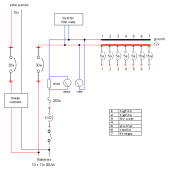sidtupper
New Member
- Joined
- May 18, 2021
- Messages
- 10
A couple of days ago, after years of problem-free operation, my power distribution circuits went crazy. Here is the layout:

I ran a vacuum cleaner off the inverter, something I've done many times before without issues, and after a minute or two it stopped. The charge controller displayed 13.8v battery voltage but the voltage across the breaker bus went down to 6v. The Low Voltage Disconnect didn't activate. I set all of the breakers to OFF and the voltage there returned to 13.8v. If I turned any of them ON, with nothing active on the circuit, eg, no lights switched on, the breaker bus voltage dropped 1 - 2 volts. I measure 1.25v from negative to earth.
Does this mean I have a ground fault? How do you locate ground faults?

I ran a vacuum cleaner off the inverter, something I've done many times before without issues, and after a minute or two it stopped. The charge controller displayed 13.8v battery voltage but the voltage across the breaker bus went down to 6v. The Low Voltage Disconnect didn't activate. I set all of the breakers to OFF and the voltage there returned to 13.8v. If I turned any of them ON, with nothing active on the circuit, eg, no lights switched on, the breaker bus voltage dropped 1 - 2 volts. I measure 1.25v from negative to earth.
Does this mean I have a ground fault? How do you locate ground faults?


